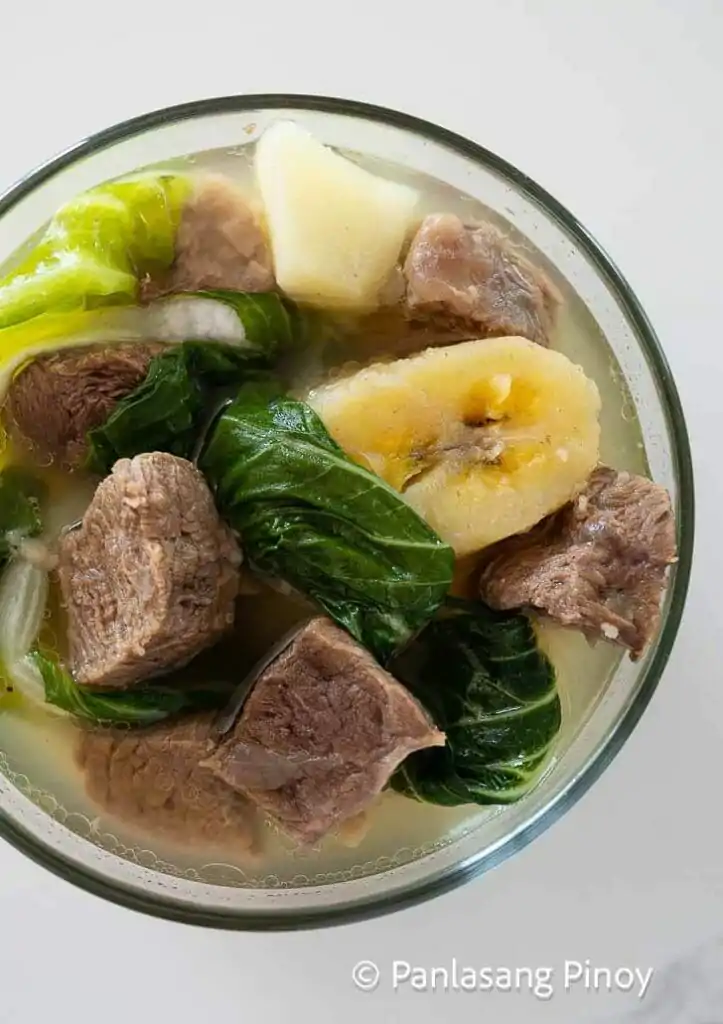Nilagang Baka, translating to “boiled beef” in Tagalog, is a quintessential Filipino dish that embodies comfort food at its finest. This hearty stew simmers tender beef chunks in a flavorful broth, generously packed with fresh vegetables and seasoned with a touch of savory fish sauce. Every spoonful is a warm hug, perfect for chilly days or simply when yearning for a taste of home.

A Symphony of Flavors:
The beauty of Nilagang Baka lies in its simplicity. The broth, built on the richness of the beef bones and aromatics like onion, garlic, and peppercorns, forms the foundation. Each added vegetable contributes its unique melody:
- Potatoes and carrots bring starchy sweetness and earthy depth.
- Green beans add a crisp, vibrant counterpoint.
- Cabbage infuses a touch of peppery bite.
- ** leafy greens** like bok choy or pechay offer a final fresh flourish.
The secret weapon? A splash of patis (fish sauce) adds umami complexity, tying all the flavors together in a harmonious embrace.
Recipe for a Cozy Nilagang Baka:
Ready to bring the warmth of Nilagang Baka to your kitchen? Here’s a simple recipe to guide you:
Ingredients:
- 1 kg beef shank or chuck roast, cut into bite-sized pieces
- 1 onion, chopped
- 4 cloves garlic, minced
- 1 teaspoon whole black peppercorns
- 8 cups water
- 1 tablespoon fish sauce
- 2 medium potatoes, peeled and quartered
- 1 carrot, peeled and sliced
- 1 cup green beans, trimmed and cut into 2-inch pieces
- 1/2 head cabbage, cut into wedges
- 1 bunch leafy greens (bok choy, pechay, or spinach)
- Salt to taste
Instructions:
- Simmer the beef: In a large pot, combine beef, onion, garlic, peppercorns, and water. Bring to a boil, then reduce heat, cover, and simmer for 1-2 hours, or until beef is tender. Skim off any scum that rises to the surface.
- Add the vegetables: Stir in fish sauce, potatoes, and carrots. Simmer for 15 minutes, or until potatoes are almost tender.
- Finish the stew: Add green beans and cabbage, simmer for another 5 minutes. Finally, stir in leafy greens and cook for just 1-2 minutes, until wilted. Season with salt to taste.
Serving up Comfort:
Ladle steaming bowls of Nilagang Baka into rice bowls, and don’t forget the accompaniments! A squeeze of fresh calamansi or a pat of patis adds a zingy touch, while chopped green onions and chilies offer a spicy kick. For an extra dose of Filipino warmth, serve alongside lumpia spring rolls or pan de sal rolls.
Beyond the Recipe:
Nilagang Baka is a canvas for culinary creativity. Feel free to add other vegetables like corn, okra, or eggplant. Experiment with different cuts of beef, like bone marrow for extra richness. You can even swap the beef for pork or chicken to create variations.
No matter how you personalize it, Nilagang Baka remains a testament to the simple pleasures of comfort food. So gather your loved ones, simmer up a pot of this heartwarming stew, and let the flavors transport you to a cozy corner of Filipino culinary bliss.
Buckwheat Pancakes: A Delicious and Nutritious Gluten-Free Breakfast
here are some frequently asked questions about Nilagang Baka, along with answers to help you make the perfect pot of this comforting Filipino stew:
What cut of beef is best for Nilagang Baka?
Traditionally, Nilagang Baka is made with beef shank, a well-marbled cut that becomes melt-in-your-mouth tender with slow simmering. However, you can also use chuck roast, blade roast, or even brisket for a richer flavor. Just be sure to adjust the cooking time depending on the cut you choose.
What can I substitute for fish sauce?
Fish sauce adds a unique umami depth to Nilagang Baka, but if you don’t have it or prefer a vegetarian option, you can substitute with soy sauce or a combination of oyster sauce and salt. Keep in mind that these substitutions may alter the flavor slightly.
What vegetables can I add to Nilagang Baka?
Nilagang Baka is a versatile dish that welcomes a variety of vegetables. Feel free to add other favorites like corn, okra, eggplant, or even green peas. You can also adjust the amount of vegetables depending on your preference for a brothier or heartier stew.
How can I make Nilagang Baka more flavorful?
For an extra layer of richness, try adding a beef bone marrow piece to the pot while simmering the beef. You can also toast the whole black peppercorns in a dry pan before adding them to the broth for a more intense peppery aroma.
What are some good side dishes for Nilagang Baka?
Nilagang Baka pairs perfectly with steamed rice. For a more satisfying meal, serve it alongside lumpia spring rolls, pan de sal rolls, or a simple green salad. Don’t forget the chopped green onions and chilies for those who like a bit of spice!
Tips for storing and reheating Nilagang Baka:
Nilagang Baka tastes even better the next day! Let the stew cool completely, then store it in an airtight container in the refrigerator for up to 3 days. Reheat gently over low heat on the stovetop, adding a splash of water if needed.
With these tips and a little love, you’re sure to master the art of making Nilagang Baka and bring a taste of Filipino comfort to your table. So go ahead, fire up the stove, and simmer up a pot of this heartwarming stew!